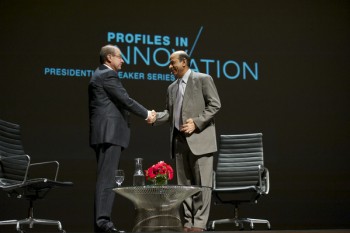Global business strategist Vijay Govindarajan said on Monday evening at Northeastern University that reverse innovation represents one of the biggest opportunities for corporate growth in America over the next several decades.
“Reverse innovation will transform just about every industry, including energy, healthcare, transportation, housing, and consumer products,” explained Govindarajan, who coined the term in 2009 while working as a chief innovation consultant at General Electric.
The term refers to the process by which companies in emerging markets produce inexpensive goods and services to meet the needs of the poor and then repackage them as cost-effective innovations for Western buyers. It has inspired Govindarajan’s eponymous New York Times and Wall St. Journal bestseller and helped propel him to the third spot in the latest Thinkers50 list of the world’s most influential business minds.Govindarajan discussed the global phenomenon with hundreds of students, faculty, and staff who filled Blackman Auditorium Monday night for the fifth installment in the “Profiles in Innovation” Presidential Speaker Series. Several hundred people who could not attend the event watched it live via Northeastern’s Facebook page.
President Joseph E. Aoun hosted the program, which is designed to bring the world’s most creative minds to campus for conversations on innovation and entrepreneurship.
Over the course of his hourlong lecture, Govindarajan gave three examples of reverse innovation in the developing world, all of which offer universal access to world-class quality at an ultra-low cost: a $30 artificial leg made of recycled plastic yogurt containers by a doctor in Thailand; a $500 electrocardiogram machine made by General Electric and sold in some 225 countries; and $2,000 heart surgery at the Narayana Hrudayalaya Hospital in Bangalore, a health clinic which has been called the “Henry Ford of heart surgery.”
But reverse innovation, a term Govindarajan repeated at least half a dozen times, is about far more than reducing cost for the sake of poor consumers. “It is about pushing the performance paradigm and offering more for less,” he explained. “As counterintuitive as it may seem, the quality demanded by poor people tends to be higher than the quality demanded by the rich.”
To prove his point he recalled the case of the cost-effective artificial leg sold in Thailand, where the chief occupation is farming and subsistence depend on biking, climbing trees, and walking on wet surfaces. “That means that you have to make an artificial leg that is superior in quality to the one we have for $20,000,” Govindarajan explained.
Govindarajan also discussed his global initiative to design a $300 house, which he first described last year in a blog post for the Harvard Business Review. He framed housing as a human right, noting that “even spiders have homes,” and professed his goal of leading the effort to build a home that prevents the spread of cholera, malaria, and tuberculosis.
“This is a challenge for business,” he explained. “Charity can not solve the problems of the poor. There is not enough money in the world.”
And yet Govindarajan is adamant that American corporations are ill prepared to transform their businesses by taking advantage of some six billion so-called non-consumers, saying they are “poorly positioned to capture this opportunity.”

President Joseph E. Aoun (left) greets business strategist Vijay Govindarajan on Monday night at the Profiles in Innovation Presidential Speaker Series.
He cited the failure of Kellogg to take hold of India’s hot breakfast market. Instead of making a brand of corn flakes that remains crisp in hot milk, which Indians are fond of pouring over their cereal, they simply offered alternative flavors. “American companies are trying to unlock opportunities in emerging markets using American logic,” he said. “Therefore they miserably fail.”
Govindarajan has also collaborated with Ravi Ramamurti, Distinguished Professor of International Business and Strategy at Northeastern, coauthoring a seminal paper on reverse innovation that was selected by Germany’s European Business School as the best article on innovation management published in 2011.
Prior to Govindarajan’s lecture, audience members were treated to a fun video spoofing the concept of reverse innovation and featuring Aoun. After his lecture, he fielded questions posed by audience members and social media users, one of whom asked him for advice on becoming a successful social entrepreneur.
“Keep your ambition high,” Govindarajan responded. “Humans rarely outperform their ambition and rarely exceed expectations. The real question you have to ask yourself is, ‘What is your ambition?'”
Aoun asked Govindajaran why reverse innovation could not take root in a developed nation like the U.S., which has a large contingent of non-consumers.
“There are about 40 million American non consumers of healthcare in the U.S.,” Govindajaran explained, “but corporations don’t allocate resources for small customer segments. In India and China there are billions of non-consumers, so there is a willingness to allocate resources.”